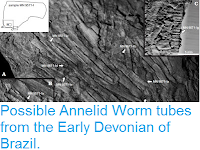Thousands of Fat Innkeeper Worms, Urechis caupo, have been found washed up on beaches in the Drakes Bay area of the Point Reyes National Seashore in northern California. The Worms, which are also known as 'Penis Fish', due to their somewhat distinctive appearance, appeared on he morning of Wednesday 11 December 2019, having apparently been scoured from burrows in the intertidal zone by a strong storm. This is a common phenomenon in the area during El Niño years, when packages of warm, wet air bring stormy conditions to the east coast of North America, but not other wise, with the effect that large numbers of Worms will appear on beaches mysteriously after several years of not being seen at all.
Thousands of Fat Innkeeper Worms, Urechis caupo, washed up on a beach in the Drake's Bay area of northern California this week. David Ford/Bay Nature.
Fat Innkeeper Worms, Urechis caupo, are a type of Spoon Worm, Echiura, a form of unsegmented marine Worm formerly thought to have been a separate phylum, but which have now been shown to be a type of Polychaete Annelid that have lost their segmentation. These Worms have a large fleshy proboscis which can be flattened into a scoop when burrowing, giving them the name 'Spoon Worms', and in the case of the large Fat Innkeeper, a rather phallic appearance.
A Fat Innkeeper Worm, Urechis caupo, found on a beach in the Bodega Bay area of northern California in June 2019. Kate Montana/iNaturalist.
Most Spoon Worms are confined to deepwater environments, predominantly in the Atlantic Ocean. Only two species are known from the West Coast of North America, the Fat Innkeeper, and the smaller Listriolobus pelodes, which is found in deeper environments (18-155 m) off the coast of California and Baja California. The Fat Innkeeper is found in intertidal waters between Oregon and Baja California , and is an important part of the local ecology, excavating large, u-shaped burrows around a meter in length. which are shared by many other species, including the Clam, Cryptomya californica, the Sequined Scale-worm, Hesperonoe advento, the Pea Craba, Scleroplax granulata and Pinnixa franciscana, the Hooded Shrimp, Betaeus longidactylus, and the Arrow Goby, Clevelandia ios. It is the provision of large burrows shared with a community of other animals which gives the worm the common name Fat Innkeeper/ The Worms are also an important prey species for many other animals, including Sea Otters, Enhydra lutris, a wide range of Fish, Sharks, and Rays, and Humans.
The El Niño is the warm phase of a long-term climatic oscillation affecting the southern Pacific, which can influence the climate around the world. The onset of El Niño conditions is marked by a sharp rise in temperature and pressure over the southern Indian Ocean, which then moves eastward over the southern Pacific. This pulls rainfall with it, leading to higher rainfall over the Pacific and lower rainfall over South Asia. This reduced rainfall during the already hot and dry summer leads to soaring temperatures in southern Asia, followed by a rise in rainfall that often causes flooding in the Americas and sometimes Africa. Worryingly climatic predictions for the next century suggest that global warming could lead to more frequent and severe El Niño conditions, extreme weather conditions a common occurrence.
Predicted changes to North American weather patterns during an El Niño event. NWS/NCEP Climate Prediction Center/NOAA.
The relationship between storm conditions and inshore sedimentary environments is complicated, as such events can scour sediments from shallow environments and shift them into deeper ones, move large volumes of sediment from terrestrial environments to shallow marine ones, or simply move sediments from beach to beach. For smaller infaunal species with shorter life-spans, such changes are not a problem, but for long-lived species such as Fat Innkeepers, which can live for around 25 years, this is a major problem as it means fewer Worms live out their full life-cycle, and that each worm therefore produced fewer offspring during its life. Even if the Worms are able to maintain a population during such a crisis, with Worms producing enough larvae during their shorter lives to keep colonising new suitable sites as they appear, this would be a major problem for the species that share the Worms' burrows, as fewer Worms would reach their full potential size, leading to fewer, and smaller burrows being available.
See also...
Follow Sciency Thoughts on Facebook.









